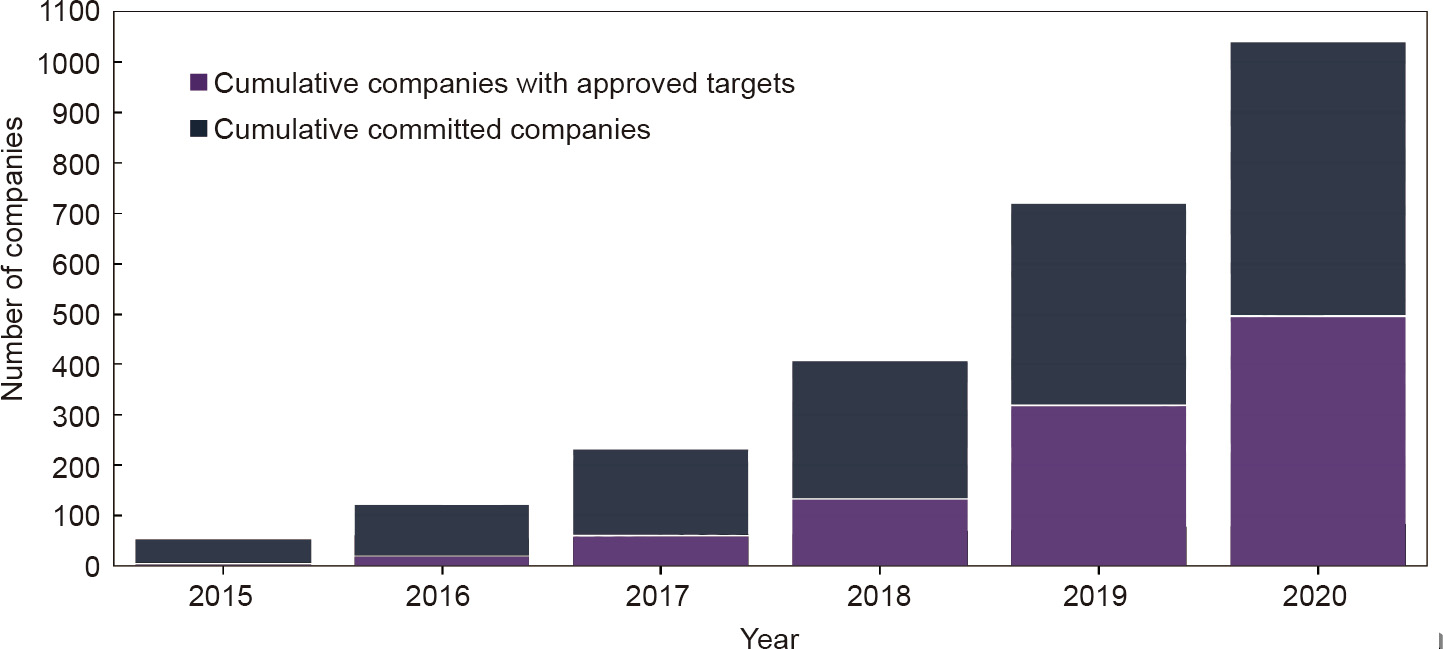Check the news lately, and it seems yet another company has just announced its intention to help tackle the climate crisis. From technology to consumer products, to furniture, to airlines, to energy, the corporate climate pledges keep coming. Typically, the companies set a date by which to achieve carbon-neutrality across their operations, declaring their support for the Paris Climate Agreement (Table 1 [1,2]). For Amazon, that target date is 2040 [3]. Unilever has committed to net zero emissions by 2039 [4]. IKEA goes even further with its pledge to become climate positive by 2030, meaning its operations will result in a net decrease in greenhouse gas emissions [5].
《Table 1》
Table 1 Examples of corporate climate pledges announced since September 2020.

Sources: Carbon removal corporate action tracker [1]; Science Based Targets initiative [2].
While keeping track of precisely how many such pledges have been made globally is difficult, one 2020 report counts more than 1000 companies across 60 countries as having made some form of commitment to reduce their emissions to align with what is thought necessary to avoid the worst impacts of climate change [6]. And it also shows how the pace of making such pledges has accelerated in the last five years (Fig. 1 [6]).
《Fig. 1》

Fig. 1. The number of companies making climate pledges has accelerated in the last five years. The graph shows the cumulative number of companies working with the Science Based Targets initiative (SBTi) to reduce their emissions in support of Paris Climate Agreement targets (data on graph reflects company activity from 28 May 2015 to 31 October 2020) [6]. ‘‘Committed” means a company has announced its intent to develop a plan with SBTi; the purple represents companies that have SBTi-approved targets and plans. Credit: SBTi, with permission.
Many climate change experts see the pledges as encouraging and made, for the most part, in good faith. If the companies follow through, the positive effects of making good on their pledges could ripple across the global economy and greatly reduce emissions. However, the pledges are all voluntary commitments, said Simon Nicholson, professor of international relations and co-founder of the Institute for Carbon Removal Law and Policy at American University in Washington, DC, USA. And, so far, most lack detailed road maps toward decarbonization, begging the question of whether there is more to some pledges than being good for business at the moment. The suspicion that they may be just another marketing opportunity has led to accusations of ‘‘greenwashing,” implying that while a company can look green on the outside, it may be business-as-usual inside.
The problem is that the fine details of many plans, so far, remain vague, said Nicholson. And it is the specific actions companies take that will determine their impact on climate change. ‘‘I always want to look at the details of the pledges,” said Andrew Hoffman, professor of sustainable enterprise at the University of Michigan in Ann Arbor, MI, USA. ‘‘If they go straight to buying carbon offsets, I do not put much stock in that because they can stop buying them next year. It does not mean any serious change in their operations or the products they sell.”
The climate pledges typically include three general elements: removing carbon, replacing fossil fuels with clean energy, and increasing energy efficiency. Carbon removal is usually a primary action promised, with an on-going tracking project finding it included as a general strategy in most company pledges [1]. This emphasis is consistent with the agreement by most experts that some form of carbon removal will be a necessary part of any successful effort to limit or reverse climate change [7]. In most pledges, however, carbon removal means carbon offsets, basically a financing mechanism to fund emission reduction projects. Each carbon offset represents a reduction of one tonne of CO2 emissions, typically achieved through activities such as reforestation (Fig. 2), renewable energy projects, changing agricultural practices, and capturing methane emissions from landfills. In essence, purchasing carbon offset certificates offers companies a way to counter their greenhouse emissions by paying for someone’s else’s carbon removal efforts. It is, in a way, a voluntary carbon tax.
《Fig. 2》

Fig. 2. Workers plant trees in Kalimantan, Indonesia. Because they capture carbon, such reforestation efforts have been adopted as one way to offset the greenhouse gas emissions driving climate change. Credit: John Pickering, The Australian Department of Foreign Affairs and Trade (CC BY 2.0).
Perhaps not surprisingly, the carbon offsets scheme has its critics. It can be challenging to verify that they actually result in long-term removal of carbon from the atmosphere and that they represent a genuine offset of emissions [8]. Their use is also limited by the finite amount of carbon that can be stored in forests and soil [9], as well as the number of businesses working to put it there. ‘‘If a handful of companies count all the currently available biological carbon removal space against their emissions, there is nothing left for anybody else,” said Nicholson. In other words, relying solely on carbon offsets to solve climate change is unlikely to be a successful long-term strategy.
Negative emissions technologies (NETs), such as direct air capture and bioenergy with carbon capture and storage (BECCS), offer another option for carbon removal [7], and some companies have included these in their pledges. United Airlines, Shopify, Occidental Petroleum, and Stripe, for example, are among the companies that are directly investing in NETs [10]. With current NET capacity consisting of a handful of pilot projects, however, these currently expensive technologies will need scaling up to make much of an impact in global emissions. While it is possible that corporate investment could help drive their adoption, the widespread deployment of NET will also need government investment and changes in policy, said Nicholson.
And some form of actual carbon removal will be necessary for companies to reach their net zero emissions targets. ‘‘There are going to be pieces of just about every business operation that are going to be very difficult, almost impossible to decarbonize,” said Nicholson. ‘‘If you are actually serious about zero carbon being the target, then some amount of carbon will have to be pulled out of the atmosphere.”
As also reflected in many pledges, using clean energy and improving energy efficiency provide important focuses for businesses to meet the goals of their climate pledges. Achieving zero carbon emissions would, however, likely require changing entire supply chains in order to eliminate the ‘‘embedded carbon” of products—the total carbon emissions associated with production from raw materials and including delivery to the consumer [11].
Even if companies take some actions, it could be difficult to meet their climate pledge goals without making major changes in how they do business. Meeting those goals could also come at the expense of negative impacts on other environmental and social issues. To power the world on renewable energy within the capacity of the planet’s natural resources, most experts believe a change in consumption patterns will also be needed [12,13]. ‘‘The biggest thing that we as a global civilization need to reckon with,” said Nicholson, ‘‘is the long-term compatibility of our economic and political systems with ecological realities.”
If a company meets its emissions goal but continues to pursue unconstrained growth, that could have a negative impact on other key resources, said James Ward, professor of environmental engineering at the University of South Australia in Adelaide, SA, Australia. Expanding production every year will drive greater energy demand, with more solar panels and wind farms needed to meet that demand. And that will require ever increasing space, as well as raw materials like silica and rare earth metals. ‘‘It is important that we move beyond looking at only carbon, to looking at the overall footprint within the context of a finite world,” said Ward.
Even business leaders have recognized that the planet’s limited resources could impede continued growth in consumption. The World Business Council for Sustainable Development, a chief executive officer-led organization based in Geneva, Switzerland, states that ‘‘consumption as usual represents a threat, both locally and globally, to the natural resources on which we depend, and therefore to the wider socio-economic system” [14]. Further, by 2050, ‘‘additional demand for materials, energy and other ecosystem services will most likely outpace efficiency gains in the supply chain and overwhelm natural systems.”
And while technological advances may offset the environmental impacts of continued economic growth, expecting this to happen indefinitely may be unrealistic. ‘‘For non-substitutable resources such as land, water, raw materials and energy, we argue that whilst efficiency gains may be possible, there are minimum requirements for these resources that are ultimately governed by physical realities,” write Ward and his co-authors in a 2016 paper in PLOS ONE [15].
The good news is that our world in 2050 could be a lot easier to live in than currently predicted if—greenwashing aside—most companies deliver on their climate pledges. Meanwhile, greater transparency and third-party monitoring could help motivate companies to do so [11]. For example, the San Francisco, CA, USA, non-profit CarbonPlan independently analyzes and rates the proposed carbon removal projects of companies [16]. The Science Based Targets initiative, a Villeurbanne, France-headquartered, global partnership of the non-profit environmental agency CDP, the United Nations Global Compact, the World Resources Institute, and the World Wide Fund for Nature, also independently works with companies to set—and then track and validate—credible, impactful, and actionable emissions and decarbonization targets [17].














 京公网安备 11010502051620号
京公网安备 11010502051620号




